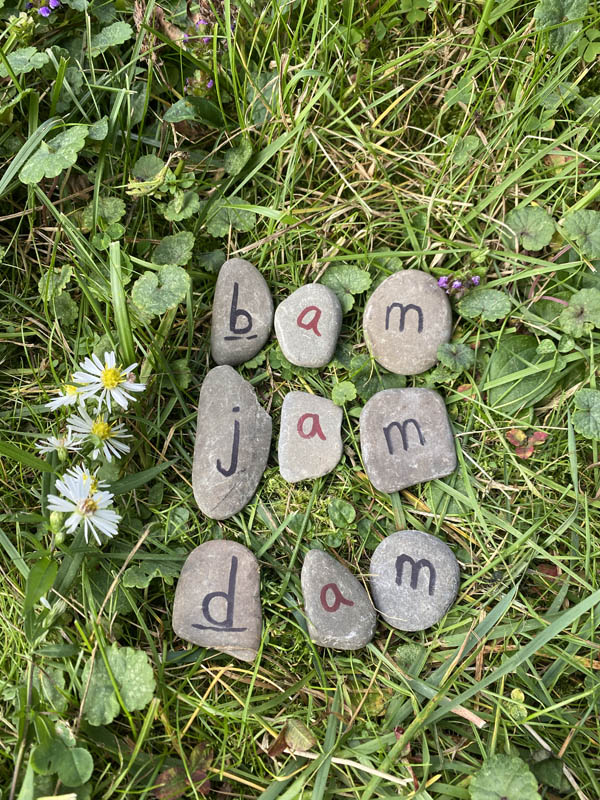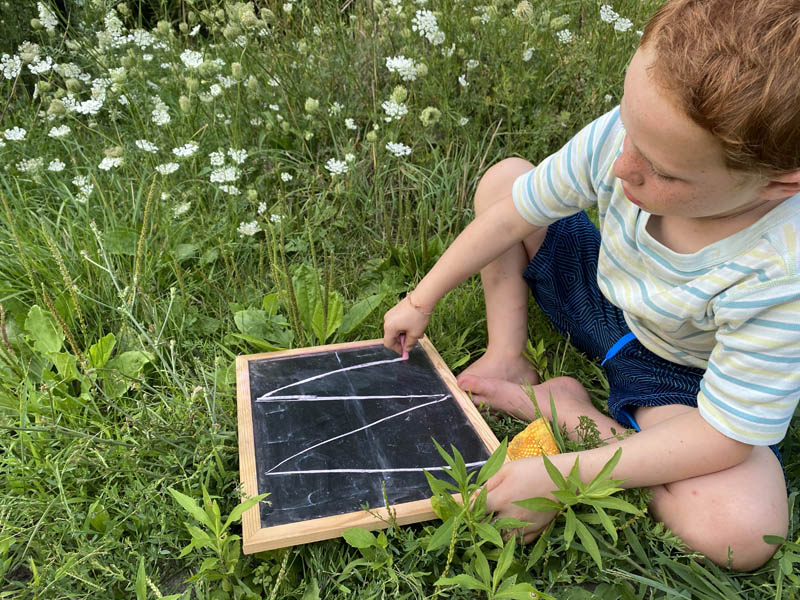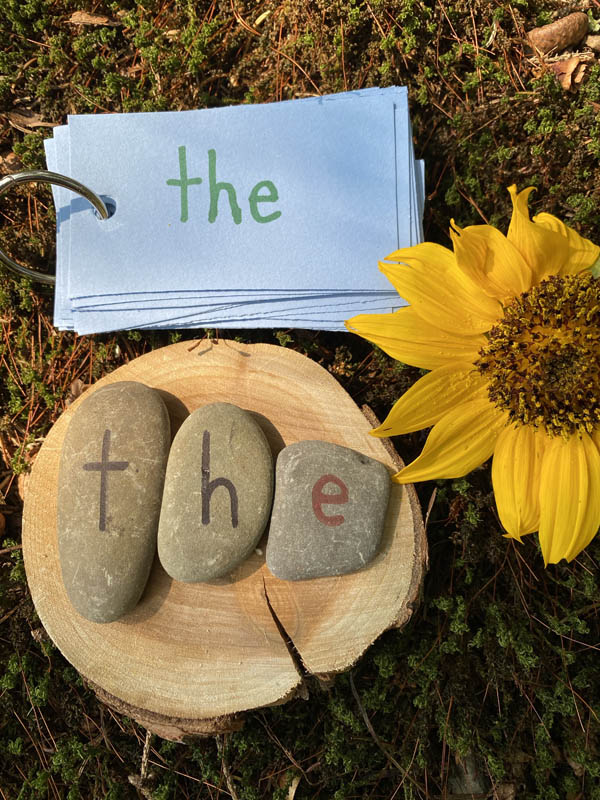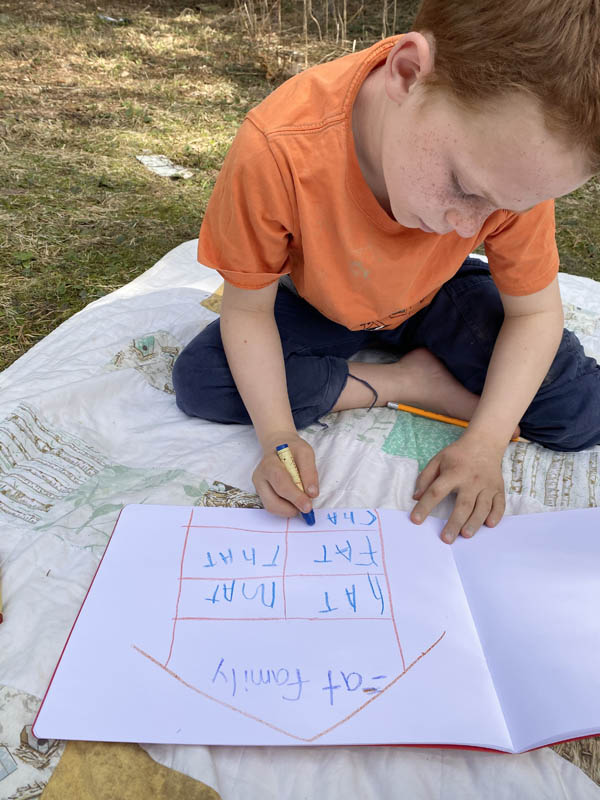
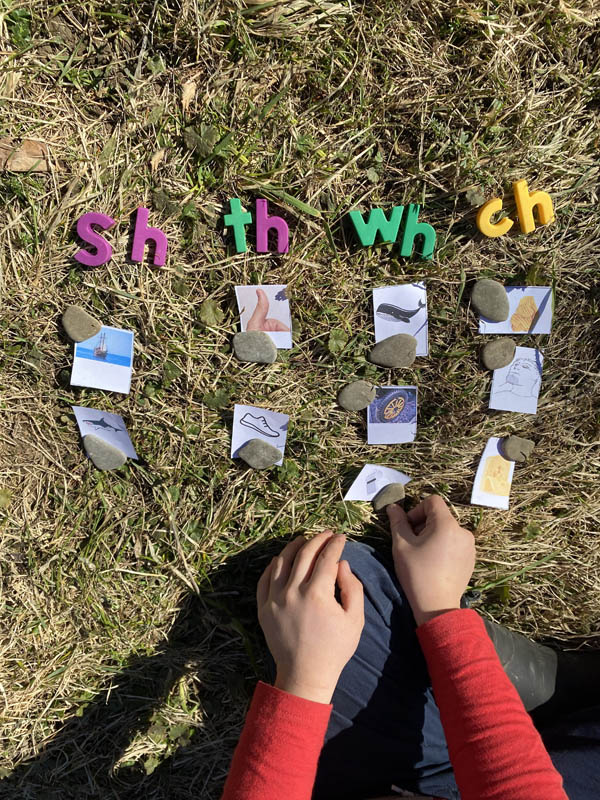
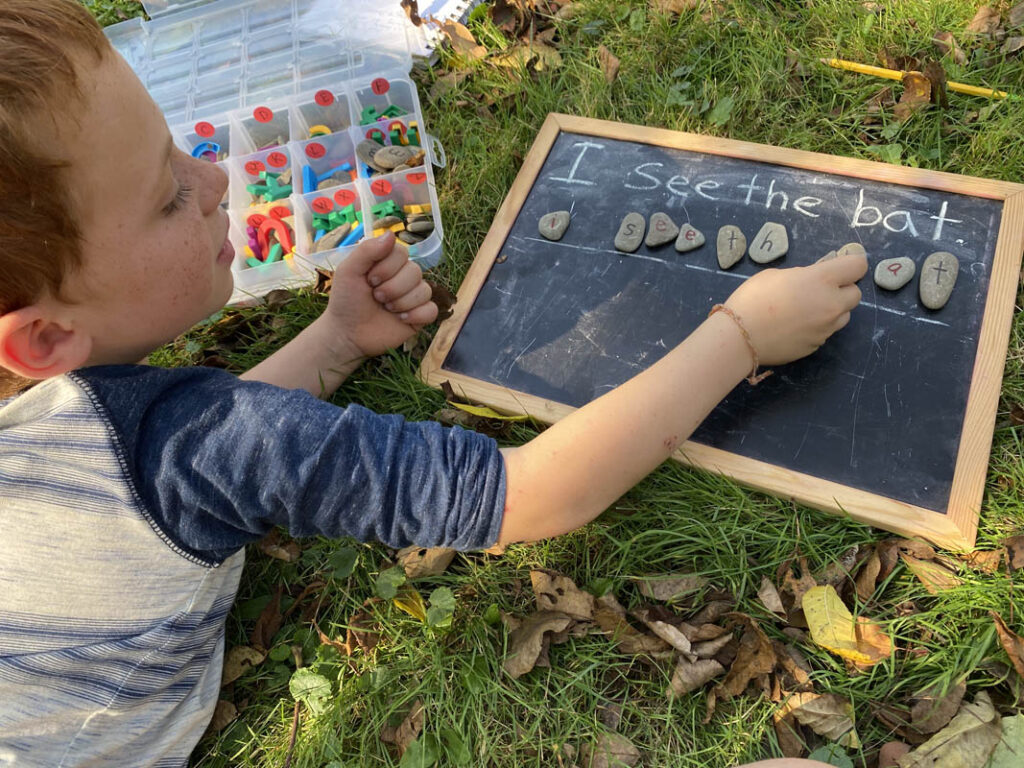
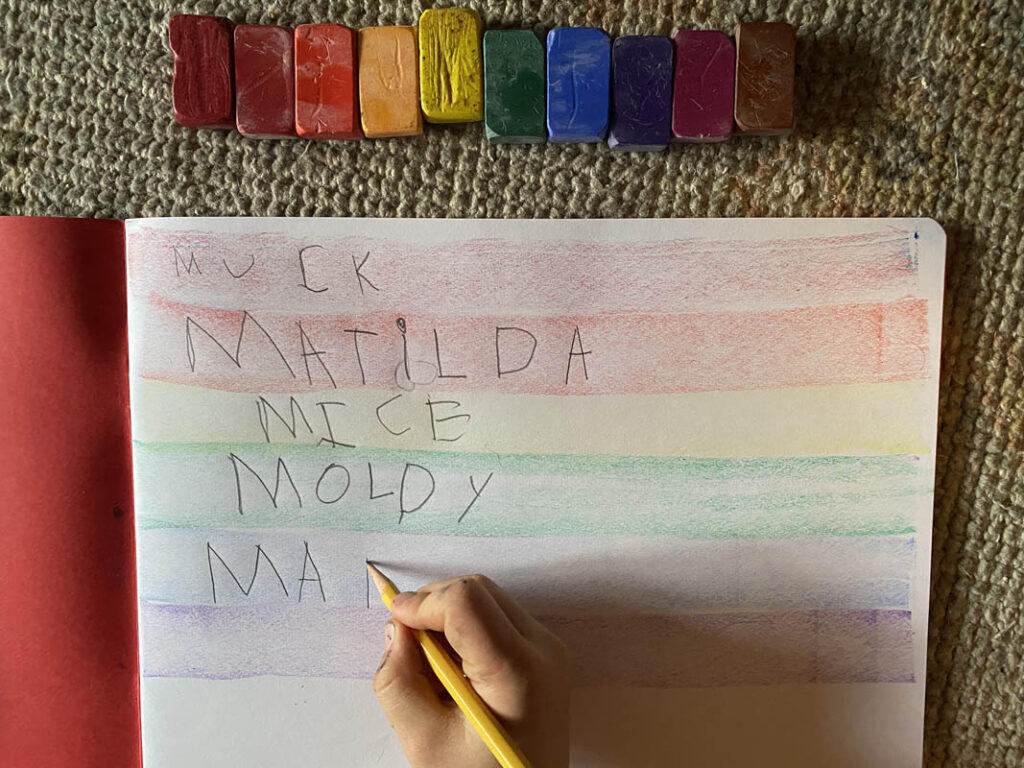
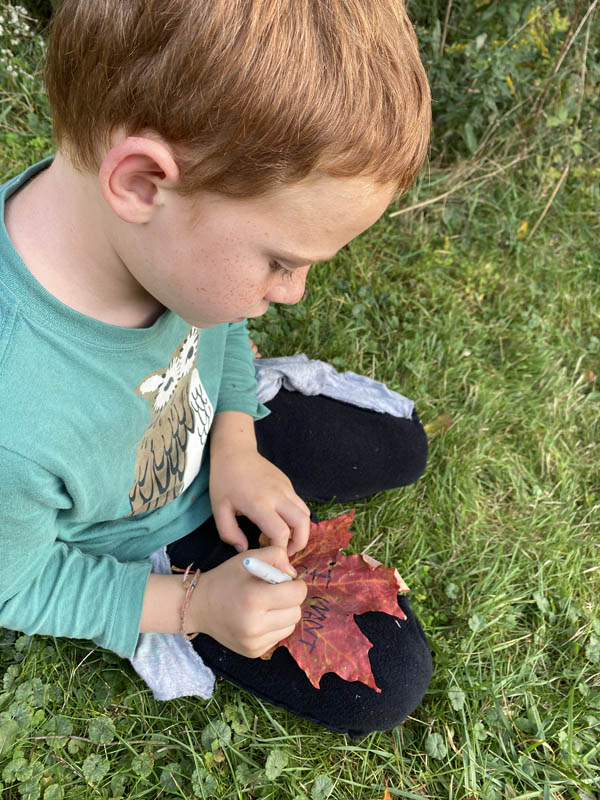
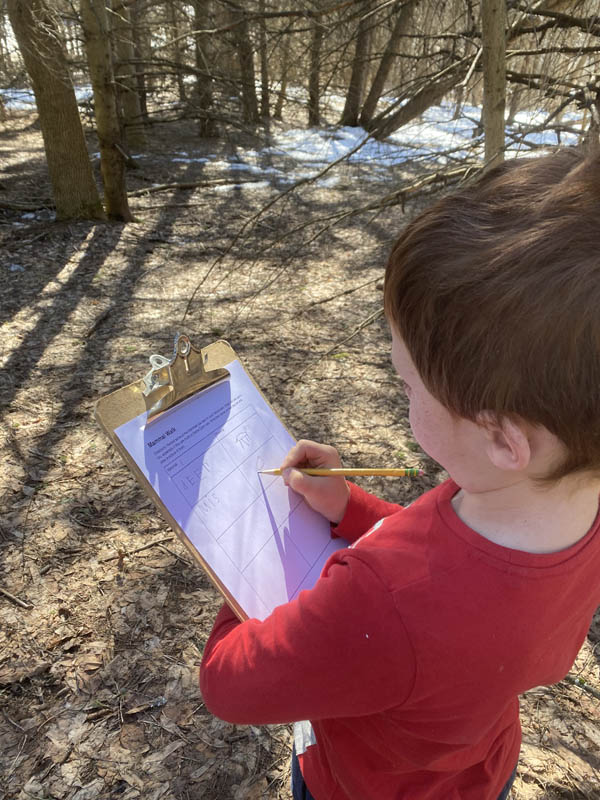
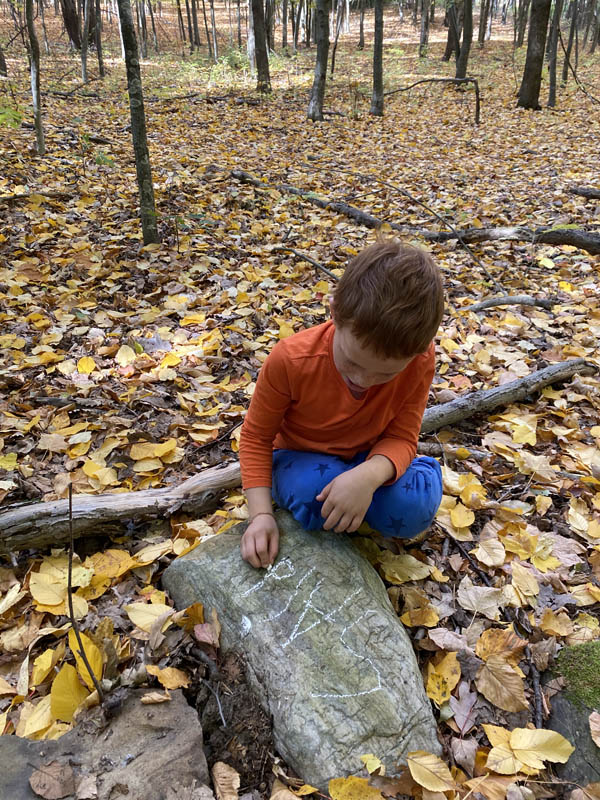

Wild Reading® Level 1 is a complete, research-informed reading program that blends outdoor learning, multisensory methods, and the joy of storytelling with a strong foundation in essential reading skills: phonological and phonemic awareness, phonics, reading comprehension, vocabulary, and writing. Drawing on years of classroom experience, doctoral research focused on literacy and curriculum design, and the science of how children learn to read, Wild Reading® offers parents a clear, engaging path for guiding their child from recognizing letter sounds to confidently reading words.
In Level 1, children learn to blend letter sounds to read words beginning with short vowels and open syllables. Phonics skills are introduced in a carefully sequenced order, following evidence-based reading instruction while incorporating the warmth of Waldorf (story-based learning and child-made main lesson books), the hands-on approach of Montessori (including the moveable alphabet), and the wonder of nature-based education. This creates a program that is both rigorous and gentle—helping children develop reading skills in a meaningful and joyful way.
Wild Reading® takes beginning readers on a story-based journey following Matilda the Mouse and her adventures to the top of a marvelous mountain.
Each week builds on a year-long story that weaves together and revisits letter sounds in meaningful ways. Rather than focusing on isolated letters, the storyline connects and organizes phonics skills so students continually review and apply what they’ve learned. Each chapter is paired with engaging lessons and activities in phonological awareness, letter formation, word families/phonics, common “sight” words, writing, independent reading practice using decodable books, and other key literacy skills. This integrated structure helps students see how letter sounds and reading skills work together as part of a larger, connected whole.
Comprehension skills are developed in several ways. Matilda’s story is rich and full of vocabulary. Words in the story are highlighted and discussed. Discussion questions based on the story and highlighting different comprehension skills are provided.
Suggested read-alouds help children build the background knowledge and vocabulary that are essential for reading comprehension. Recommended picture and nonfiction book lists provide additional choices for read-alouds and further exploration of enrichment topics. Books with diverse characters are clearly marked.
Each week follows a consistent, easy-to-follow rhythm, with both weekly and daily schedules provided for guidance. The structure offers a sense of flow and predictability, while most activities are designed with built-in flexibility, allowing families to adjust the amount of outdoor instruction to fit their needs, interests, and learning pace.
A wide variety of enrichment activities cover a range of subjects, including nature study, science, art, movement, and music. Providing choices in these areas enables families to tailor the program to their child’s interests and learning style.
Wild Reading® is recommended for children ages 5–8 years old. Reading readiness depends on the child. For most children, this is usually around the age of 6 or 7.
Your child is ready for the entire Wild Reading® program if:
Don’t worry if you are unsure of what some of these skills are or why they are important. I devoted a whole section in Wild Reading® on how to teach reading and the science behind it!
*When we refer to sight words in Wild Reading®, we are referring to a list of words we want to prioritize the children learn to read because they are so common. These words can be phonetically regular or irregular. Read more about sight words in the next section.
Introduction of letter sounds through the story Tilda Trekker, Fairy Fred, and the Marvelous, Mighty, Majestic Mountain by Monica Bosworth
Tilda Trekker, Fairy Fred, and the Marvelous, Mighty, Majestic Mountain follows Matilda the mouse as she discovers the world beyond her home in a moldy mattress. She catches a glimpse of a majestic mountain and decides she must see the top! Each week you follow Matilda and later, her friend Fairy Fred on their adventures up the mountain.
Their journey takes them through all 26 letters of the alphabet, ending with X (at the apeX of the mountain), and their return from the summit during the final two chapters.
Letter pages and word families
Each week your child will create pages featuring the week’s letter, sight word, and, if applicable, the word family/ies (word families are introduced after the letter A). They will also practice letter formation using multisensory methods.
You will collect the weekly letter sound, sight word, and word family pages that your child makes to create three books. You will construct them together with your child at the end of the year. They are an excellent way to showcase and document their work at the end of the year.
Word families as a developmental step before phonics
According to Dr. David Kilpatrick4, teaching word families helps children begin reading while also honing their phonological awareness skills. This happens because word families scaffold their developing skills by using rime* unit patterns.
*A rime unit is the part of a syllable that contains the vowel and all the consonants following it. For example, in the word “cat,” the onset is c and the rime unit is -at.
[1]Kilpatrick, D. (2016). Equipped for Reading Success: A Comprehensive, Step by Step Program for Developing Phonemic Awareness and Fluent Word Recognition. Casey and Kirsch Publishers.
Wild Reading’s Approach to High Frequency or “sight” Words
When we refer to “sight” words in Wild Reading, we are referring to words we want to students to read because they are so
common and are essential for making simple sentences such as “is” or “the”. These words can be phonetically regular or irregular. The focus is not on memorizing these words, but rather, helping students decode and form an orthographic map of the word so that it can be recognized by the brain instantly (see next section).
When possible, these words are introduced at the same time as a related skill (at is taught when short a is introduced).
If the words are decodable, attention should be on sounding the words out. We draw students’ attention to the phonemes and the letters to assist with the brain process of orthographic mapping. As explained in more detail in the next chapter, children do not memorize what words look like visually, instead they use the process of orthographic mapping to effortlessly learn and
recall words instantly.
When introducing sight words that have unexpected sounds or advanced patterns, such as the words “is” or “the,” we call attention to both the letters that do have typical sounds and those that do not
make sounds we expect. For example, the short I sound in the word “is” or the /th/ sound in the word “the” make the sounds that we expect, and this should be discussed. It is equally important to call attention to letters and combinations of letters that do not make the sounds we would expect. For example, the S in “is” makes a /z/ sound and the E in “the” does not make the short or the long E sound. By drawing attention to the phonemes and letters in this way we support a child’s developing orthographic mapping of these words which appropriately supports the brain to read these words automatically. In some cases, this may mean introducing sounds and letters that have not been learned yet (As a reminder, students should know most of their letter sounds before starting Wild Reading).
Each week children are introduced to 1–2 high
frequency words. They make a word page for
each word using pictures and simple sentences. These pages help them create meaning and context for words that when isolated in this manner can be abstract.
Language and Reading comprehension skills
Being able to sound out words effectively is essential, but in order to have good reading comprehension, a child needs to know what the words mean. Building a strong vocabulary is essential so that when children can read these words, they will know what they mean. Matilda’s story is full of a variety of vocabulary words. Definitions for advanced words are included at the end of every chapter, so you can discuss them with your child after you read.
Language and reading comprehension is also developed using the story by asking questions about that week’s chapter of the story, both at the beginning and end of every week. These questions are based on key concepts and skills that are later necessary for independent reading, such as making predictions, retelling, making connections, inferences, and summarizing.
Quality read alouds and enrichment activities help build background knowledge and language skills while children are learning the basic skills of reading. These are essential for reading comprehension development.
Spelling
The spelling of short vowel words is incorporated into word family instruction, strategies for sounding or blending words, and in activities. Wild Reading® encourages children to use their knowledge of letter sounds and phonemes when spelling words they do not know. This further assists and supports children’s phonological awareness development. Spelling words in this way helps children listen and think about the different sounds and the letters that make them at the word level.
The importance of multisensory reading activities
Multisensory instruction requires children to use more than one sense at a time. Using different senses such as seeing, hearing, touching, and movement in an activity gives children multiple ways to make connections in their brains about what they are learning. Wild Reading® uses multisensory activities such as word building with the moveable alphabet, scavenger hunts, word sorts, skywriting, sand or salt tray writing and numerous other activities to engage the senses when learning new skills.
In addition, this program incorporates plenty of outdoor learning. Some activities are directly related to observing and learning more about nature while integrating reading and writing skills and some are focused more on honing a particular skill (such as word sorts).
Enrichment activities
The enrichment activities provided in Wild Reading® loosely follow the letter theme introduced each week in the story chapter. They provide ways to integrate other subjects, skills, and some fun into the homeschool day, while reinforcing key literacy skills. Academic subjects covered by the activities include science, wilderness skills, math, art, music, language arts, and play-based activities. Feel free to dive into a particular activity or topic and extend it over multiple days or even weeks if your child is particularly engaged with it. Icons representing each academic area help you quickly identify which activities cover specific subject areas.
Below is a list of essential supplies commonly used in the majority of activities in Wild Reading. Each chapter contains a list of specific materials needed for that week. Additional materials, such as paper and pencil, are also needed and listed in the curriculum. Additional materials for individual enrichment activities are listed for each activity.
Many of these materials can be found on the Wild Math Amazon Store at: www.amazon.com/shop/wildmathcurriculum
You can see the Wild Reading’s full scope and sequence by clicking the link below. This is not a letter a week program, Rather the storyline which is organized by letters connects and organizes phonics skills so students continually review and apply what they’ve learned.
https://discoverwildlearning.com/wp-content/uploads/2021/06/Scope-and-Sequence-Wild-Reading.pdf
Wild Reading® is a digital curriculum. You will receive two files, the main curriculum (384 pages) and the printable resources (48 pages). You can print it at home, at a print shop (online or brick and mortar), or use it digitally (only printing the printable resources).
Shops such as Hardcopy HQ specialize in printing for homeschoolers and typically are much more affordable. The price was less than half that of the chain/big office type printers.
You may also choose to print off one chapter each week (about 10-15 pages). This can be a great strategy to print at home but not overwork your printer!
The story and weekly plan are included in each chapter. While it looks lovely in color, black and white is the most economical way to print a document this size! You can always refer to the digital copy if you would like to see a section/picture in color. I have a few small businesses I recommend for printing in the FAQ section.
It has come to our attention that the book Series Fun Tales by Duane Bolin and Sarita Holzmann can be difficult to source or shipping can be excessive. It is shipped internationally by Sonlight.
I have found some downloadable decodable readers by Grade One Snapshots @gradeonesnapshots that are a suitable replacement. Some of the sight words may be slightly off of the schedule.
Here is a Sequence with the alternate books.
Links to Grade One Snap Shot books
Grade One Snapshots Decodable Readers Set 1
https://www.teacherspayteachers.com/Product/Decodable-Readers-to-Support-the-Science-of-Reading-Set-1-6270883
Set 2
https://www.teacherspayteachers.com/Product/Decodable-Readers-to-Support-the-Science-of-Reading-Set-2-6271348
We are working on adding videos to support parents and teachers with teaching some of the elements of Wild Reading® that may be new such as syllable division. You can see our current videos at https://www.youtube.com/@discoverwildlearning/videos
